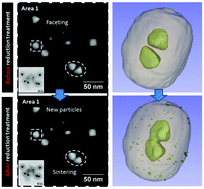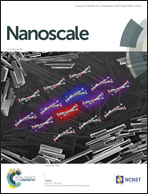Thermal behavior of Pd@SiO2 nanostructures in various gas environments: a combined 3D and in situ TEM approach†
Abstract
The thermal stability of core–shell Pd@SiO2 nanostructures was for the first time monitored by using in situ Environmental Transmission Electron Microscopy (E-TEM) at atmospheric pressure coupled with Electron Tomography (ET) on the same particles. The core Pd particles, with octahedral or icosahedral original shapes, were followed during thermal heating under gas at atmospheric pressure. In the first step, their morphology/faceting evolution was investigated in a reductive H2 environment up to 400 °C by electron tomography performed on the same particles before and after the in situ treatment. As a result, we observed the formation of small Pd particles inside the silica shell due to the thermally activated diffusion from the core particle. A strong dependence of the shape and faceting transformations on the initial structure of the particles was evidenced. The octahedral monocrystalline NPs were found to be less stable than the icosahedral ones; in the first case, the Pd diffusion from the core towards the silica external surface led to a progressive decrease of the particle size. The icosahedral polycrystalline NPs do not exhibit a morphology/faceting change, as in this case the atom diffusion within the particle is favored against diffusion towards the silica shell, due to a high amount of crystallographic defects in the particles. In the second part, the Pd@SiO2 NPs behavior at high temperatures (up to 1000 °C) was investigated under reductive or oxidative conditions; it was found to be strongly related to the thermal evolution of the silica shell: (1) under H2, the silica is densified and loses its porous structure leading to a final state with Pd core NPs encapsulated in the shell; (2) under air, the silica porosity is maintained and the increase of the temperature leads to an enhancement of the diffusion mechanism from the core towards the external surface of the silica; as a result, at 850 °C all the Pd atoms are expelled outside the silica shell.

- This article is part of the themed collection: 2018 Nanoscale HOT Article Collection


 Please wait while we load your content...
Please wait while we load your content...